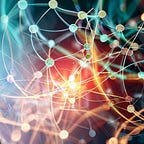What is life?
Let’s start with a thought experiment and imagine that we are an intelligent designer. After we have managed to convert energy into matter in a singular event and this beautiful game called the universe has evolved, we now want this matter to evolve itself. How do we do that? We are experimenting with different molecules and hope that something will come out of their combination. And indeed, we are succeeding. Some of these molecules form a group that sustains itself by producing the substances it needs for its existence. Let’s call this autocatalysis. To do this, it extracts energy from the outside, converts it and exports the energy it consumes to the outside. This creates a stable reaction circuit, which is ultimately separated from the environment by a membrane.
We are thrilled, but quickly realize that this group, let’s call it a cell, is hardly developing any further. It changes the planet by producing oxygen, but it remains almost nearly the same.
We use a trick and make sure that this cell does not live forever, but after a certain period of time passes on more complex properties to new cells that continue their existence, so to speak. To do this, we implant a nucleus with a complex genome into the cell that stores its experiences. By passing it on to daughter cells, one’s own experience is then passed on and more variants are created by mutations, which then cause development, so that different types develop faster, from which new types arise again, etc.
So we have initiated a rapid evolution and are now observing how it plays out. When we look again after some time, we notice that multicellular organisms have evolved that even have organs and a brain with which they can orient themselves highly effectively. We are fascinated by the complexity and adaptability of these organisms. The most complex, humans, are highly sensitive and die relatively quickly, but through their ability to store experiences outside their bodies, let’s call it culture, they have changed the planet just as permanently as the first single-celled organisms did.
We wonder what is the secret of this impressive development. It was the trick with the nucleus and the genome. Imbalances have arisen because the genome has a controlling effect. In it, the density of structure, one could also say the density of information, was at its highest, and this was the only way to achieve the causal force that resulted in both a necessity and a possibility of embarking on more complex developments.
At the same time, new developments have produced new regulatory systems that have not replaced the old ones, but have integrated them. This has resulted in an enormously complex overall system that has led to this insane center of information processing in humans that we call the brain. Here, too, the principle of imbalance applies, with the resulting local density of structure and information, both within the organism and within the brain.
It follows that these beings, especially humans, are not dumb automatons, but self-governing organisms. Once these organisms have sensors that are bundled in the brain, as well as a hormonal system that regulates the interaction of the organs, these organisms feel. This means that the perception of stimuli as well as their processing is evaluated somatically. This gives rise to entire emotional worlds as a seemingly independent system.
Human’s highly complex brains no longer only serve their immediate spatial and temporal orientation, but also enable them to generate their own fantasies.
While the interplay of the regulatory levels from the cell to the brain builds on each other, the opposite path applies due to the density of information with regard to the causal force, but without interfering with the respective principles of these levels. Their dynamics are preserved, but changes are possible, as psychosomatics and epigenetics show.
We are amused to see that people are trying to build machines that work just like they do. They do not seem to have yet understood the principles on which their existence rests. These are autocatalysis, which applies at all levels of regulation, as well as the imbalance, which only enables them to act independently through different structural densities. And finally, sensations are only possible with an endocrine system, which first ‘somatizes’ information, i.e. makes it sentient. This is not possible with simple silicon-based calculating machines. Autocatalysis in the brain forms thoughts, which cause further thoughts with which the exchange of information with the world takes place. The imbalance and thus the structural differences make thinking possible in the first place.
This is where our short thought experiment ends. If you replace the intelligent designer with chance, you’ve probably come closest to reality.
As long as neuroscientific theories of consciousness, as well as theories of artificial intelligence, do not take these three principles into account, they will remain unsuccessful. *
— — — — — — — — — — — — — — — — — — — — — — — — — -
* I’ve described these principles in several posts here on Medium
